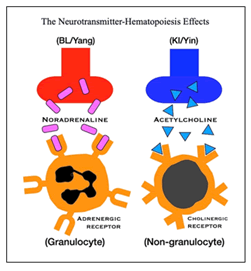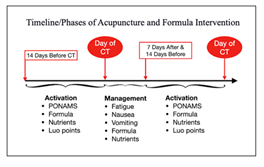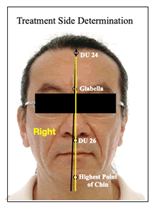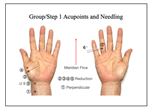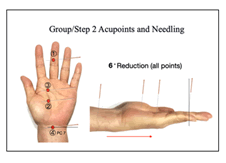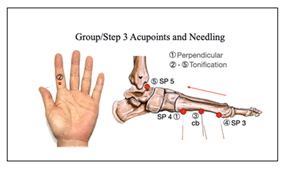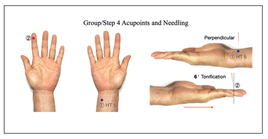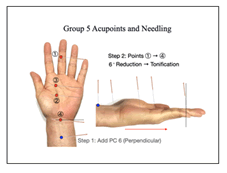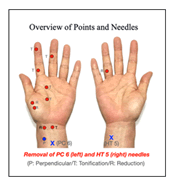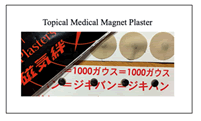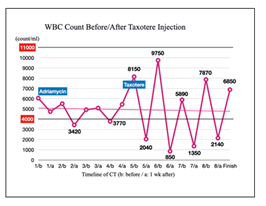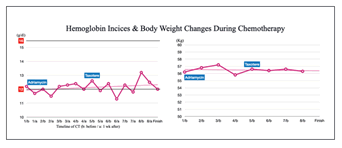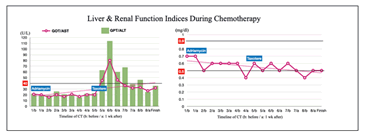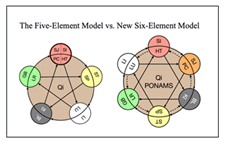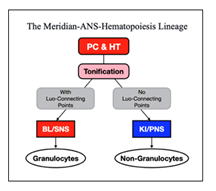The Modulatory Effects of Acupuncture and Herbal Formula on White Blood Cell Hematopoiesis in A Triple-Negative Breast Cancer Patient: A Case Report
Eric Mengchen Hao*
Acupuncture Center for Intractable Pain (ACIP), Taipei City, Taiwan, ROC
- Corresponding Author:
- Eric Mengchen Hao
Acupuncture Center for Intractable Pain (ACIP),
Taipei City, Taiwan, ROC
E-mail: acip.ponams@gmail.com
Received date: January 09, 2023, Manuscript No. IPMCRS-23-15616; Editor assigned date: January 11, 2023, PreQC No. IPMCRS-23-15616 (PQ); Reviewed date: January 20, 2023, QC No. IPMCRS-23-15616; Revised date: January 31, 2023; Manuscript No.IPMCRS-23-15616 (R); Published date: February 07, 2023, DOI: 10.36648/2471-8041.9.1.259
Citation: Hao EM (2023) The Modulatory Effects of Acupuncture and Herbal Formula on White Blood Cell Hematopoiesis in a Triple-Negative Breast Cancer Patient: A Case Report. Med Case Rep Vol.9No.1:259.
Abstract
Background: Chemotherapy is critical to Triple-Negative Breast Cancer (TNBC) patients due to the negative response to hormonal and target therapy. Chemotherapy-induced neutropenia is one of the major side effects that prematurely discontinue or terminate cancer treatment. Reports indicate that the granulocyte colony-stimulating factor is widely used to raise the white blood cell count and is associated with neo-carcinogenesis despite pre-existing cancer.
Objectives: This report aims to examine the modulatory effect of acupuncture and herbal formula on endogenous white blood cell hematopoiesis in a TNBC patient during chemotherapy.
Materials and Findings: A 52-year-old female diagnosed with TNBC was managed with acupuncture and herbal formula alongside conventional chemotherapy. Acupuncture (twice/week, 40 min/session), daily herbal decoctions, and magnets on HT 5 and PC 6 at a designated time in a day were introduced two weeks before administering Taxotere. The white blood cell count was monitored one week after the chemotherapy and re-checked the day before the next Taxotere injection. The liver and renal functions, hemoglobin, and body weight were recorded. Totally four courses of acupuncture/formula interventions were carried out. White blood cell count rose to normal before each Taxotere administration. The considerable increment disproportionates the chemotherapeutic agent’s cumulative toxicity to the liver and kidney functions, while body weight and hemoglobin level remain relatively stable during the course.
Conclusions: White blood cell production can be modulated by regulating sympathetic activities in a TNBC patient. The finding implies that autonomic dysfunctions and immune-associated disorders may benefit from the protocol.
Keywords: Case report; Chemotherapy-induce neutropenia; Triple-negative breast cancer; Acupuncture; Hematopoiesis; Herbal formula
Abbreviations: ANS: Autonomic Nervous System; BC: Breast Cancer; BL: Bladder (meridian); CIN: Chemotherapy-Induced Neutropenia; CT: Chemotherapy; DU: Du or Governing channel; ER: Estrogen Receptor; G-CSF: Granulocyte Colony Stimulating Factor; HER2: Human Epidermal growth factor Receptor 2; HT: Heart (meridian); KI: Kidney (meridian); NSP: Neutrophil-Stimulating Protocol; PC: Pericardium (meridian); PFA: Protocol-Forming Algorithms; PHF: PONAMS Herbal Formula; PNS: Parasympathetic Nervous System; PONAMS: Power of Nature Acupuncture Medical System; PR: Progesteron Receptor; SI: Small Intestine (meridian); SJ: San Jiao (meridian); SNS: Sympathetic Nervous System; SP: Spleen (meridian); ST: Stomach (meridian); TAE: Tonify Assisting Element; TCM: Traditional Chinese Medicine; TP: Tonify Parents; WBC: White Blood Cell
Introduction
Chemotherapy (CT) is one of the limited available therapeutic options besides surgery and radiotherapy for the treatment of Triple-Negative Breast Cancer (TNBC) due to its negative responses to hormonal and target therapy [1-3]. Chemotherapeutic drugs often cause Chemotherapy-Induced Neutropenia (CIN) that prematurely discontinues the therapy and leaves patients susceptible to lethal infections [4-6]. Therefore, increasing the White Blood Cell (WBC) count to accomplish the CT courses is vital for TNBC patients to lower the recurrence and increase the survival rate.
Granulocyte Colony-Stimulating Factor (G-CSF) is widely used to mobilize hematopoietic stem cells and multiply the WBC to counteract CIN [7,8]. However, G-CSF is also associated with highly aggressive and poor prognostic secondary tumor formation [9]. The G-CSF's tumor-promoting effect raised the concern of increasing the risk of developing additional malignancies besides TNBC.
Acupuncture has been incorporated into the cancer treatment protocol, but the procedures were not systemized, and the clinical results were inconsistent [10,11]. However, acupuncture may effectively regulate Autonomic Nervous System (ANS) activities and treats ANS-associated disorders by balancing sympathetic and parasympathetic excitement [12]. Furthermore, increasing evidence also supports the ANS activities link to hematopoiesis, including WBC [13-15]. These findings suggest an alternative solution to CIN to finish CT courses as scheduled without subjecting to G-CSF's tumor genesis risks.
In-depth review of TNBC, CIN, G-CSF, and acupuncture's effects on autonomic activities, around 15%-20% of Breast Cancer (BC) are triple-negative [16]. TNBC is an invasive BC that responds poorly to hormonal or target therapy [17-20]. The clinical characteristics of TNBC are the aggressive nature, pathological heterogeneity, unfavorable prognosis, the specific pattern of lung and brain distant metastases [2,21], and a high recurrence rate after CT [17,22]. The recurrence rate of stage I-III TNBC patients is around 40% after completion of treatment [23] and the 5-years survival rate is poorer compared with patients with other types of BC [24-27].
Chemotherapeutic drugs commonly used to treat BC often cause various side effects, including CIN [28,29]. Clinically, G-CSF is the primary measure taken to initiate WBC hematopoiesis. However, reports found that G-CSF links to aggressive and poor prognostic secondary carcinogenesis [9,30,31] and raised concern about triggering additional tumor formation despite TNBC's high recurrence rate.
Innate immunity plays a critical role in forming an anti-tumor microenvironment and activating adaptive immune cells, such as T and B lymphocytes, that enhance BC treatment outcomes [32]. In addition, the Sympathetic Nervous System (SNS) and Parasympathetic Nervous System (PNS) have demonstrated physiological hematopoietic effects on various blood and immune cells [13,14] (Figure 1). Other researchers also reported that the activation of SNS is highly associated with WBC formation [15,33]. Therefore, endogenous hematopoiesis holds a less risky yet effective intervention than the G-CSF for managing CIN.
Figure 1: Excitation of SNS or PNS generates corresponding neurotransmitters that act on progenitors to differentiate and proliferate desired blood cells. SNS-noradrenaline-WBC (left) and PNS-acetylcholine-T/B lymphocytes (right) are two primary pathways associated with blood/immune cell hematopoiesis.
Growing data supports that acupuncture positively correlates to neurotransmitters, endocrine, and immune activities [34-37]. However, the five elements' core theory of "a mother-element generates the son-element" does not fulfill the law of nature that Traditional Chinese Medicine (TCM) and acupuncture have claimed. Unlike the "mother-only" conception, almost all species in nature require both genders to reproduce next generations [38]. Clinical reports indicated that incorporating a "father element" into the foundation and clinical practice resolved intractable pain and functional disorders with significant outcomes [39-41].
In this report, a Neutrophil-Stimulating Protocol (NSP) derived from the Power of Nature Acupuncture Medical System (PONAMS) was applied to a TNBC patient to examine the modulatory effects of acupuncture and herbal formula on the acupuncture-ANS-hematopoiesis lineage in a TNBC patient during CT.
Case Presentation
Profile of the study subject
In summary, a 52-year-old Asian female unexpectedly found a painless nodule in the upper-left quadrant of her left breast. A pathological biopsy confirmed the diagnosis of TNBC. A combined treatment plan of surgery, CT, and radiotherapy was recommended.
The patient is a firm believer in TCM and voluntarily asked to incorporate acupuncture and herbal formula alongside conventional treatment after diagnosis and consultation with the oncologist and author. The patient had no history of any pre-existing medical condition, neuropathy, cancer, or chemotherapy except for the low average hemoglobin level. She is a non-drinker and nonsmoker and lives a healthy lifestyle with an optimal body mass index. She noticed the asymptomatic painless nodule existed by accident when taking a shower. After breast sonography, tumor marker tests for breast cancer (CA-125), mammography, and needle aspiration biopsy, the diagnosis of TNBC staging T1N0M0 was confirmed, which indicated no pathological or radiographic evidence of lymph nodes involvement and distant metastasis with a tumor size smaller than 2 cm in diameter [42]. She received a partial mastectomy followed by eight courses of CT (Adriamycin and Taxotere, four courses each) and 30-day radiotherapy.
NSP formation
Taxotere is a chemotherapeutic agent known for inducing muscle/joint pain [43,44], peripheral neuropathy [45,46], and CIN [47,48]. The NSP was customized and introduced two weeks before and seven days after each Taxotere administration based on the following:
- WBC’s lifespan ranges from 11 to 16 days (or two weeks on average). The maturation and storage of WBC account for the majority of the WBC’s life [49].
- The relationship between ANS and hematopoietic stem cell mobilization [15].
- PONAMS, the modified TCM and acupuncture theoretical framework [38].
- The oncologist judges whether G-CSF is required according to the previous WBC restoration rate, the study subject's preference, and the WBC count one week after each Taxotere injection.
Treatment timeline
The treatment timeline (Figure 2) was created primarily according to the time required for WBC hematopoiesis in the Bone Marrow (BM).
Figure 2: The protocol timeline and phases. Hematopoiesis was activated (activation phase) two weeks before the succeeding CT using NSP. The first week after Taxotere injection focuses on side effect management (management phase), followed by another 14-day activation. Customizing diet/nutrient supplementation based on the subject’s demonstrating cold/heat/excess/deficiency patterns.
Activation phase: The NSP started 14 days before the first and each following Taxotere injection to mobilize hematopoietic progenitor cells. A blood test was done before injection on the day of CT to decide whether the therapy may proceed. Oral folic acid (400 mg tablet/day) was added to the regimen to assist red blood cell formation for the subject’s low average hemoglobin.
Management phase: The drop in WBC count is anticipated after each CT. The management during this period focuses on side effects, such as poor appetite, nausea and vomiting, and fatigue, by daily acupuncture of ST 36, ST 39, PC 6, SP 3, and HT 7 points. A blood sample was taken on the seventh day after each CT to monitor the WBC numbers. Resume another two weeks of the activation phase after the management phase.
Treatment procedure
The NSP comprises five groups/steps of acupoint, an herbal formula (Table 1), and topical medical magnets application. The numbers in each group of points indicate the needling sequence. They must be successively followed to unblock the blockage and generate therapeutic momentum. Many acupoints do not exist in traditional acupuncture and require accurate point location to gain the desired results.
Table 1: Ingredients and dosages of formula and collaborative effects with magnets.
| Ingredients and Dosages |
FuLing/12 g GouTeng/12 g (cook the last) BaiShao/9 g ChaiHu/9 g QiangHuo/9 g HuangQi/9 g ZhiGanCao/9 g |
|
| Magnets | On | Off |
| Time | 7 am-9 pm | 9 pm-7 am |
| Actions | ANS/WBC | PNA, T-cells/B-cells |
| Note: PONAMS-based herbal formula used in conjunction with acupuncture for WBC hematopoiesis. Topical magnets are required for SNS (Yang) excitation during designated hours in the daytime. | ||
Acupuncture protocol: Choosing an appropriate treatment side is essential in obtaining the optimal outcome and avoiding unnecessary needling (Figure 3, an example of author's photo). The two lines, one (black) connects the midpoint of the anterior hairline (roughly DU 24) and glabella, and another (yellow) connects a depression under the nasal spine (roughly DU 26) and the highest point of the chin, are used to differentiate the ratio of right versus left face. The face on the convex portion (a more considerable amount) serves as the treatment side. The shallower nasolabial fold depth (right-hand side in Figure 3) can assist in verifying the ratio. This report uses the subject's left-hand face as the treatment side based on the same assessment. The acupoint combinations fall primarily on the left hand/foot and a few on the opposite side based on PONAMS Protocol-Forming Algorithms (PFA).
Acupuncture was performed twice per week, 40 min/session. The needle length is determined by the amount of muscle associated with points. DBC needles (0.22 mm x 15 mm) were used for points in phalangeal bones. The 0.22 mm x 30 mm needles were used in the points in the metacarpal, metatarsal and around the wrist and ankle joints. The needling depth depends on the thickness of the muscle and is required to reach close/next to the underlying bones. The arrival of Qi (DeQi) is a prerequisite before introducing tonification or reduction. Practicing the tonification or reduction by tilting needle tips along or against the meridian flow direction by 6 degrees [50,51]. Re-stimulating each needle for 10-15 seconds every 10 minutes using the twist-whirl technique [52].
The first group of points (Figure 4): On the left Lung (LU) meridian and right ring finger. Point 1 is perpendicularly inserted, and the rest are reduced by tilting the needle tips toward the wrist/elbow with a 6 degrees inclination to go against the Lung (LU) meridian flow. Points 1 to 4 do not exist in traditional acupuncture and need practicing for accurate location. The second group of points (Figure 5): The points are on the left Pericardium (PC) meridian. Exercising reduction to all acupoints by inclining the needle tips toward the wrist/elbow to go against the PC meridian flow. Points 1, 2 and 3 are not traditional acupoints. The third group of points (Figure 6): The acupoints are on the left Spleen (SP) meridian in the foot and the left hand. Among the five points, points 2 and 3 are PONAMS's points. Point 1 (SP4) is perpendicularly inserted. The rest of the points are tonified by tilting the needle tips toward the ankle or fingertips with a 6 degrees inclination. The fourth group of points (Figure 7): The points are on both hands. Point 1 is HT 5 (right hand) and is perpendicularly inserted, while Point 2 is on the left index finger, tonified by tilting the needle tips toward the fingertips. The fifth group of points (Figure 8) is identical to group two plus PC 6 on the left PC meridian. In this step, insert PC 6 perpendicularly, then apply tonification to the previously reduced points by 1) pulling up the needle to close to the skin surface but still in the tissue, 2) tilting the needle tips toward the fingertips with a 6 degrees inclination, and 3) re-inserting the needles to the desired depth with DeQi again.
Figure 4: Group 1 points on the left LU meridian and right ring finger. Perpendicular insertion for Point 1. The rest of the points are reduced by tilting the needle tips 6 degrees toward the wrist/elbow. Source: Group 1_Point 1, Group 1_Point 2, Group 1_Point 3_4, Group 1_Point 5.
Figure 5: Group 2 points on the left PC meridian. Point 1 is on the left middle finger. Points 2 and 3 do not exist in the traditional acupoint system. Point 4 is identical to PC 7. Using the reduction method for all points. Source: Group 2_Point 1, Group 2_Point 2_3, Group 2_Point 4.
Figure 6: Group 3 points are on the left index finger and the left foot. Perpendicular insertion for SP 4 and tonification for the rest of the points by tilting needle tips 6 degrees towards the ankle/fingertips. Source: Group 3_Point 1_3_4_5, Group 3_Point 2.
Figure 7: Group 4 points are on both hands. Point 1 is the right HT 5, and Point 2 is on the left index finger's distal phalanx. Perpendicular insertion for HT 5 and tonify the rest points by tilting the needle tip towards the fingertips. Source: Group 4_Point 1_HT5, Group 4_Point 2.
Figure 8: Points in this group are identical to group 2 plus left PC 6. Perpendicular insertion for PC 6 and replace the reduction method with tonification. Wait for 15 mins. Source: Group 5_Point PC6.
Leaving the needles in place for fifteen to twenty minutes after finishing needling. The points of groups four and five, the Luo-connecting points on PC 6 and HT 5, are keys to triggering WBC hematopoiesis. The therapeutic effect is to excite SNS activity and subsequent WBC proliferation and maturation by puncturing the two Luo-connecting points. The last step (Figure 9) is to remove two needles in the Luo-connecting points, left PC 6 and right HT 5, and then re-stimulate the rest of the points. Figure 9 illustrates an overview of the points and needling angles. Stimulating acupoints without Luo-connecting points raises PNS activity and interrelated immune cell production. Again, waiting for additional fifteen minutes before removing all needles and finishing the treatment. In Group 5 and the last step, SNS (Yang) and PNS (Yin) activities are stimulated to restore the system's Yin-Yang balance without compromising the conventional CT courses.
PONAMS-based Herbal Formula (PHF) and topical magnets: Table 1 lists the ingredients and dosages of PHF and the timing of topical magnets to prolong and maintain the hematopoietic effect initiated by acupuncture. The topical medical magnets (Figure 10) work alongside PHF to direct the formula’s actions on either sympathetic activity (with magnets) or parasympathetic activity (without magnets). The ratio of applying magnets on PC 6 s and HT 5 s during the daytime to without magnets at night is 14:10 to favor WBC hematopoiesis as the sleeping quality is undisturbed. In this case, the day (defined as 7 am-9 pm) matches a regular individual’s daily activity and leaves 9 pm to 7 am for resting at nighttime.
Results
Figure 11 shows the total WBC count on the day of CT before the Taxotere injection and the seventh day after the injection. In this case, Adriamycin caused nausea, vomiting, loss of appetite, and diarrhea with early signs of chemotherapy-induced peripheral neuropathy in fingers and leukopenia (2/a, 3,420/ml, the lowest). The NSP started 14 days before Taxotere administration (4/a), and the total WBC count reached 8,150/ml on the day of the first injection (5/b). In the following four-course of treatments, the total WBC count dropped as anticipated on the seventh day after each CT (5/a, 6/a, 7/a, 8/a), then increased significantly to the normal range on the day before the next injection (5/b, 6/b, 7/b, and 8/b) without receiving G-CSF.
Figure 11: Anticipated CIN was noted one week after CT (5/a, 6/a, 7/a, 8/a). The WBC count increased substantially to the normal range in two weeks (6/b, 7/b, 8/b, finish) on the day before the subsequent treatment without administering G-CSF. The PONAMS' hematopoietic effects are similar to the average neutrophil recovery time (16 days, refer to the discussion) for those receiving G-CSF.
Throughout the whole course of CT, the hemoglobin level was monitored to evaluate the NSP’s effect on red blood cell formation (Figure 12, left). The data showed that the hemoglobin level slightly increased over time. The body weight remained unchanged (Figure 12, right), indicating the GI tract side effects were adequately handled in the management phase. For the liver and renal indices (Figure 13), the laboratory results demonstrated the accumulative toxicity of CT drugs to both organs’ functions. The trend lines sloped up (left, liver) and down (right, kidney) are expected with no side effects that require timely attention.
Discussion
In Figure 11, the WBC count rose considerably before each Taxotere administration without G-CSF. The WBC count reached 8,120/9,750/5,890/7,870 count/ml before the first (5/b), second (6/b), third (7/b), and fourth (8/b) injection, respectively, despite the chemotherapeutic agent's progressive myelotoxicity. Furthermore, the CIN grades [53] turned less severe over time as CT continued and were disproportionate to the accumulative toxicity exhibited in the liver and renal function indices.
Yankelevich et al. [54] reported in a randomized clinical study that the time to neutrophil recovery (absolute neutrophil count>1,000/mm3) after receiving G-CSF is 16 days. The absolute neutrophil count is averagely equivalent to 4,000-6,000 WBC count/ml. Our data revealed a similar WBC/neutrophil recovery efficacy compared with the study results. The TNBC patient's WBC restoration rate and hemoglobin index suggest that hematopoiesis is manipulable by regulating SNS activity.
The NSP was customized based on the integration of 1) A modified TCM theoretical framework, 2) A clinically proven acupuncture point system, and 3) PONAMS's PFA.
Modified TCM theoretical framework
TCM claims to be a system that unifies humans and nature despite apparent discrepancies in its theory. Contrary to the natural law that almost all species require both genders to reproduce the next generations, the "mother-only" perception is not truthful to the law of nature [38]. Therefore, incorporating the concept of a "father" completes the fundamentals and leads to a constitutionally divergent approach. The father element can be best understood and introduced by analyzing the traditional five-element model.
Figure 14 illustrates that the fire element in the conventional five-element model (Figure 14, left) contains two relevant yet distinct elements, the sovereign (Small Intestine, SI/Heart, HT) and Ministerial fire (SanJiao, SJ/Pericardium, PC). The unevenly distributed elements do not support the state of balance from the structural, natural, and practical aspects. The generating-controlling relationship raised critical thinking about inconsistent therapeutic outcomes caused by applying an imbalanced model and subsequent diagnosis and treatment. As a result, the traditional five-element was reformed, and a six-element (Figure 14, right) was established. The new model reallocates the twelve meridians evenly into six elements to reach a geometric and structural balance. Furthermore, each element is being "pointed at" (generated) by the "father and mother" to reflect the facts of nature. The treatment principle, therefore, turned from "tonifying the mother element" to "Tonifying the Parents (TP)" of a deficient element.
Figure 14: (Left) The conventional fire element (bold circle) contains two paired meridians (SJ/PC and SI/HT) that result in an imbalanced state and may contribute to potential therapeutic inconsistency. (Right) The new six-element model redistributes twelve meridians into six elements that match the state of balance and the law of nature. Each element is "generated" by father and mother elements (two solid arrows) to reflect that both genders are required to reproduce next generations in almost all species. The dotted arrows indicate the assisting elements to the following counterclockwise elements.
Increasing evidence supports that the ANS is crucial in signaling and regulating hematopoiesis besides cytokines and neurotransmitters [13,55]. For two main reasons, TCM's BL and KI meridians are comparable to SNS and PNS. First, BL/KI attribution is water, and water is the proof and the origin of life on Earth, including humans. Second, the BL and KI meridians run symmetrically and exteriorly-interiorly through the brain and along the spinal cord, where vital physiological functions are governed. Relating the SNS to BL (Yang) and the PNS to KI (Yin) renders ANS activity regulation clinically feasible by tonifying or reducing BL/KI. The parent element to the water, the sovereign, and Ministerial fire in the six-element are the two primary elements that increase or decrease ANS activity for desired hematopoiesis.
Evidence-based acupuncture point system
In PONAMS, there are nine acupuncture points on each meridian at various levels of the arms and legs. Each point on a specific meridian reflects a different body part that was clinically verified with a minimum of 70% pain relief effect [56,57]. Anatomical landmarks remain the universal standard of point locations to avoid discrepancies among practitioners using Cun, ratio, or proportion. In Chinese, "acupoint (ç©´)" is a den, hole, or cave [58]. It explicitly features an acupuncture point situated in a depression or concavity next to anatomical landmarks formed by bones, tendons, muscles, or combinations. Point location accuracy and tonification/reduction methods, the same as selecting indicated medication and dosage in conventional medicine, are keys to successfully treating diseases under the PFA’s guidance.
Protocol-forming algorithms
The PFA is the ground rule developed from integrated conventional medicine and the meridian system that guides acupuncture and formula treatment [55]. For instance, the signaling of WBC formation and maturation are in the brain (central) that acts on BM (peripheral). The clinical approach comprises selecting associated meridians, corresponding acupoints and needling sequence and appropriate tonification/reduction to accomplish hematopoiesis. The point combinations and needling sequence are imperative to managing intractable disorders, including hematopoiesis. The meridian system is a successively interconnected network. When the free flow is interrupted at any site, it impedes the meridian's free flow and creates an imbalance. Hence, finding the origin of obstruction and unblocking the blockage is fundamental to cause management as well as symptomatic relief. In many cases, an obstructed meridian may or may not be resolved due to the nature of the blockage. Introducing the meridian linkage can "detour" the blocked (diseased) meridian by utilizing one or several related meridians. Meridian linkage provides an instant bypass to resume the free flow and reduce congestion. The assisting element, the next clockwise element to the diseased meridian in the new six-element, is tonified to increase the flow volume on the bypass to expedite the decongestion while TP repairs the diseased meridian. Meridian linkage, Tonifying Assisting Element (TAE), and TP are the core procedures for resolving the cause and symptoms.
Universal acupuncture requirements
Four universal requirements must be met on top of the diagnosis, point combination, and needling sequence to obtain consistent therapeutic success. These are: 1) Precision point location, 2) the arrival Qi (DeQi), 3) adequate needling depth, and 4) appropriate tonification/reduction methods [50,51,59]. The requirements share the same essential fundamentals as in TCM and acupuncture that cannot be overly addressed and are vital to complex cases. The therapeutic momentum can be amplified and maintained as acupuncture's fundamentals are correctly practiced.
Considerations of acupuncture, PHF and magnets
In the six-element model, the PC and HT meridians are the “parents” of the water meridians (BL/KI). Excitation of SNS (tonifying BL meridian) can be best achieved using the PC and HT meridians [60]. When tonifying a Yang meridian via Yin meridians, the Luo-connecting points must be added as a portal to navigate the tonification from Yin to Yang [61]. In this case, PC 6 and HT 5 direct the tonifying effect from Yin (KI/PNS) to Yang (BL/SNS) and trigger WBC hematopoiesis (Figure 15).
Unlike traditional TCM formulating principles, PHF is compounded according to PONAMS modified theoretical framework and treatment principles. Therefore, analyzing a PHF’singredients and interpreting the formula’s actions to explore the pharmaceutical mechanisms would be inappropriate and should be avoided.
Magnets deliver constant and consistent magnetic stimulation to Luo-connecting points, making them suitable to assist the long-term hematopoietic momentum when combining PHF. As shown in Table 1, magnet application during the daytime is responsible for SNS excitation (Yang) and the subsequent WBC hematopoiesis. The nighttime PHF without magnets escalates the PNS level (Yin) for quality sleep and immune cell production. The bilateral modulation of BL/SNS and KI/PNS fits conventional medicine’s practice and adheres to the treatment principle of tonifying Yin and Yang deficiency syndromes.
By applying NSP during cancer treatment and continuing PHF as the sole maintenance regimen after CT and radiotherapy, the subject re-checked every six months and has remained cancer-free since May 2017.
Conclusion
The data showed WBC count increased substantially before each Taxotere administration without G-CSF or delaying, dose-limiting, or premature termination of CT. The subject remains cancer-free five years after the completion of conventional therapy. The outcome demonstrated an evidence-based clinical result that ANS, immune reactions, and hematopoiesis could be effectively regulated via designated acupuncture and herbal formula protocols in a TNBC patient.
Neural-hematopoiesis lineage has been well-supported by a surging amount of clinical data. Our report implies the acupuncture and herbal formula's potential for reducing or replacing the usage of G-CSF, managing autonomic dysfunctions, cancer treatment, immune reactions, and autoimmune disease management. A more in-depth and larger-scale clinical experiment needs to be conducted to verify the protocol's efficacy in the above medical conditions.
Authors' Contributions
The sole author, MH, is fully responsible for the conceptual framework, paper review, experiment design, clinical procedure execution, clinical data collection, interpretation of outcomes, and manuscript preparation and composing. MH declares and confirms the originality of all images and tables, including the presented author's profile as an example.
Acknowledgment
This research was conducted and accomplished under the full cooperation of the TNBC patient, Mrs. Chang. We thank her for volunteering and supporting completing the clinical case report.
References
- Jitariu AA, Cimpean AM, Ribatti D, Raica M (2017) Triple negative breast cancer: The kiss of death.Oncotarget8: 46652–46662.
[Crossref], [Google Scholar], [Indexed]
- Chalakur-Ramireddy NKR, Pakala SB (2018) Combined drug therapeutic strategies for the effective treatment of triple negative breast cancer.Bioscience reports38: BSR20171357.
[Crossref], [Google Scholar], [Indexed]
- Anders CK, Abramson V, Tan T, Dent R (2016) The evolution of triple-negative breast cancer: From biology to novel therapeutics. Am Soc Clin Oncol Educ Book35: 34–42.
[Crossref], [Google Scholar], [Indexed]
- https://www.cancer.org/treatment/treatments-and-side-effects/physical-side-effects/low-blood-count/neutropenia.html.
- Cavaletti G, Alberti P, Marmiroli P (2015) Chemotherapy-induced peripheral neurotoxicity in cancer survivors: An underdiagnosed clinical entity? Am Soc Clin Oncol Educ Book 35: e553–e560.
[Crossref], [Google Scholar], [Indexed]
- Miaskowski C, Mastick J, Paul SM, Topp K, Smoot B (2017) Chemotherapy-induced neuropathy in cancer survivors.J Pain Symptom Manage 54: 204–218.
[Crossref], [Google Scholar], [Indexed]
- Bendall LJ, Bradstock KF (2014) G-CSF: From granulopoietic stimulant to bone marrow stem cell mobilizing agent. Cytokine Growth Factor Rev25: 355–367.
[Crossref], [Google Scholar], [Indexed]
- Theyab A, Algahtani M, Alsharif KF, Hawsawi YM, Alghamdi A, et al. (2021) New insight into the mechanism of Granulocyte Colony-Stimulating Factor (G-CSF) that induces the mobilization of neutrophils.Hematology 26: 628–636.
[Crossref], [Google Scholar], [Indexed]
- Lyman GH, Yau L, Nakov R, Krendyukov A (2018) Overall survival and risk of second malignancies with cancer chemotherapy and G-CSF support. Anna oncol 29: 1903–1910.
[Crossref], [Google Scholar], [Indexed]
- Ben-Arye E, Shavit E, Wiental H, Schiff E, Agour O, et al. (2016) Overcoming communication challenges in integrative supportive cancer care: The integrative physician, the psycho-oncologist, and the patient.Complement Ther Med 2: 9–15.
[Crossref], [Google Scholar], [Indexed]
- Lu Z, Moody J, Marx BL, Hammerstrom T (2017) Treatment of chemotherapy-induced peripheral neuropathy in integrative oncology: A survey of acupuncture and oriental medicine practitioners. J Altern Complement Med 23: 964–970.
[Crossref], [Google Scholar], [Indexed]
- Li QQ, Shi GX, Xu Q, Wang J, Liu CZ (2013) Acupuncture effect and central autonomic regulation. Evid Based Complement Alternat Med 2013: 267959.
[Crossref], [Google Scholar], [Indexed]
- Hanoun M, Maryanovich M, Arnal-Estape A, Frenette PS (2015) Neural regulation of hematopoiesis, inflammation, and cancer. Neuron 86: 360–373.
[Crossref], [Google Scholar], [Indexed]
- Riether C, Schurch CM, Ochsenbein AF (2015) Regulation of hematopoietic and leukemic stem cells by the immune system.Cell Death Differ 22: 187–198.
[Crossref], [Google Scholar], [Indexed]
- Fielding C, Mendez-Ferrer S (2020) Neuronal regulation of bone marrow stem cell niches. F1000 Res 9: 614.
[Crossref], [Google Scholar], [Indexed]
- Mouh FZ, Mzibri ME, Slaoui M, Amrani M (2016) Recent progress in triple negative breast cancer research. Asian Pac J Cancer Prev 17: 1595–1608.
[Crossref], [Google Scholar], [Indexed]
- Andreopoulou E, Schweber SJ, Sparano JA, McDaid HM (2015) Therapies for triple negative breast cancer. Expert Opin Pharmacother 16: 983–998.
[Crossref], [Google Scholar], [Indexed]
- https://www.cdc.gov/cancer/breast/triple-negative.html
- Jhan JR, Andrechek ER (2017) Triple-negative breast cancer and the potential for targeted therapy. Pharmacogenomics 18: 1595–1609.
[Crossref], [Google Scholar], [Indexed]
- Sharma P (2016) Biology and management of patients with triple-negative breast cancer. Oncologist 21: 1050–1062.
[Crossref], [Google Scholar], [Indexed]
- Aysola K, Desai A, Welch C, Xu J, Qin Y, et al. (2013) Triple negative breast cancer-An overview.Hereditary Genet(Suppl 2): 001.
[Crossref], [Google Scholar], [Indexed]
- Palma G, Frasci G, Chirico A, Esposito E, Siani C, et al. (2015) Triple negative breast cancer: Looking for the missing link between biology and treatments. Oncotarget 6: 26560–26574.
[Crossref], [Google Scholar], [Indexed]
- Stewart RL, Updike KL, Factor RE, Henry NL, Boucher KM, et al. (2019) A multigene assay determines risk of recurrence in patients with triple-negative breast cancer.Cancer Res79: 3466–3478.
[Crossref], [Google Scholar], [Indexed]
- Dent R, Trudeau M, Pritchard KI, Hanna WM, Kahn HK, et al. (2007) Triple-negative breast cancer: Clinical features and patterns of recurrence. Clin Cancer Res 13: 4429–4434.
[Crossref], [Google Scholar], [Indexed]
- Boyle P (2012) Triple-negative breast cancer: Epidemiological considerations and recommendations.Ann Oncol23: vi7–vi12.
[Crossref], [Google Scholar], [Indexed]
- Reddy SM, Barcenas CH, Sinha AK, Hsu L, Moulder SL, et al. (2018) Long-term survival outcomes of triple-receptor negative breast cancer survivors who are disease free at 5 years and relationship with low hormone receptor positivity.Br J Cancer118: 17–23.
[Crossref], [Google Scholar], [Indexed]
- https://www.cancer.org/cancer/breast-cancer/about/types-of-breast-cancer/triple-negative.html
- https://www.cancer.org/cancer/breast-cancer/treatment/chemotherapy-for-breast-cancer.html
- Ba Y, Shi Y, Jiang W, Feng J, Cheng Y, et al. (2020) Current management of chemotherapy-induced neutropenia in adults: Key points and new challenges: Committee of Neoplastic Supportive-Care (CONS), china anti-cancer association committee of clinical chemotherapy, china anti-cancer association.Cancer Biol Med17: 896–909.
[Crossref], [Google Scholar], [Indexed]
- Karagiannidis I, De Santana van Vilet E, Said Abu Egal E, Phinney B, Jacenik D, et al. (2020) G-CSF and G-CSFR induce a pro-tumorigenic macrophage phenotype to promote colon and pancreas tumor growth.Cancers12: 2868.
[Crossref], [Google Scholar], [Indexed]
- Liu L, Liu Y, Yan X, Zhou C, Xiong X (2020) The role of granulocyte colonyâ??stimulating factor in breast cancer development: A review.Mol Med Rep 21: 2019–2029.
[Crossref], [Google Scholar], [Indexed]
- Ye Y, Xu C, Chen F, Liu Q, Cheng N (2021) Targeting innate immunity in breast cancer therapy: A narrative review.Front Immunol 12: 771201.
[Crossref], [Google Scholar], [Indexed]
- Cosentino M, Marino F, Maestroni GJ (2015) Sympathoadrenergic modulation of hematopoiesis: A review of available evidence and of therapeutic perspectives.Front Cell Neurosci 9: 302.
[Crossref], [Google Scholar], [Indexed]
- Johnston MF, Ortiz Sanchez E, Vujanovic NL, Li W (2011) Acupuncture may stimulate anticancer immunity via activation of natural killer cells. Evid Based Complement Alternat Med 2011: 481625.
[Crossref], [Google Scholar], [Indexed]
- Ding SS, Hong SH, Wang C, Guo Y, Wang ZK, et al. (2014) Acupuncture modulates the neuro-endocrine-immune network.QJM 107: 341–345.
[Crossref], [Google Scholar], [Indexed]
- Volf N, Ferdman L (2017) The mechanisms of immunomodulation in acupuncture.Int J Complement Alt Med9: 00320.
[Crossref], [Google Scholar]
- Cui J, Song W, Jin Y, Xu H, Fan K, et al. (2021) Research progress on the mechanism of the acupuncture regulating neuro-endocrine-immune network system. Vet Sci 8: 149.
[Crossref], [Google Scholar], [Indexed]
- https://www.acupuncturetoday.com/digital/index.php?i=734&a_id=33632&pn=33&r=t&Page=33
- Wong CS, Kuo CP, Fan YM, Ko SC (2007) Collateral meridian therapy dramatically attenuates pain and improves functional activity of a patient with complex regional pain syndrome. Anesth Analg 104: 452.
[Crossref], [Google Scholar], [Indexed]
- Horng HC, Kuo CP, Cherng CH, Yeh CC, Wang TC, et al. (2013) The effects of collateral meridian therapy for knee osteoarthritis pain management: A pilot study.J Manipulative Physiol Ther36: 51–56.
[Crossref], [Google Scholar], [Indexed]
- Lee SH, Lu WA, Lee CS, Wang JC, Lin TC, et al. (2014) The therapeutic effect of collateral meridian therapy is comparable to acupoint pressure therapy in treating myofascial pain syndrome.Complement Ther Clin Pract20: 243–250.
[Crossref], [Google Scholar], [Indexed]
- Edge SB, Compton CC (2010) The american joint committee on cancer: The 7th edition of the AJCC cancer staging manual and the future of TNM. Ann Surg Oncol 17: 1471–1474.
[Crossref], [Google Scholar], [Indexed]
- Chiu N, Chiu L, Chow R, Lam H, Verma S, et al. (2017) Taxane-induced arthralgia and myalgia: A literature review.J Oncol Pharm Pract 23: 56–67.
[Crossref], [Google Scholar], [Indexed]
- Chiu N, Zhang L, Dent R, Giotis A, van Draanen J, et al. (2018) A prospective study of docetaxel-associated pain syndrome. Support Care Cancer 26: 203–211.
[Crossref], [Google Scholar], [Indexed]
- Bhatnagar B, Gilmore S, Goloubeva O, Pelser C, Medeiros M, et al. (2014) Chemotherapy dose reduction due to chemotherapy induced peripheral neuropathy in breast cancer patients receiving chemotherapy in the neoadjuvant or adjuvant settings: A single-center experience.SpringerPlus3: 366.
[Crossref], [Google Scholar], [Indexed]
- Park SB, Goldstein D, Krishnan AV, Lin CS, Friedlander ML, et al. (2013) Chemotherapy-induced peripheral neurotoxicity: A critical analysis. CA Cancer J Clin 63: 419–437.
[Crossref], [Google Scholar], [Indexed]
- Ho MY, Mackey JR (2014) Presentation and management of docetaxel-related adverse effects in patients with breast cancer.Cancer Manag Res6: 253–259.
[Crossref], [Google Scholar], [Indexed]
- Zheng NS, Wang F, Agarwal R, Carroll RJ, Wei WQ, et al. (2021) Racial disparity in taxane-induced neutropenia among cancer patients.Cancer Med10: 6767–6776.
[Crossref], [Google Scholar], [Indexed]
- Abramson N, Melton B (2000) Leukocytosis: Basics of clinical assessment.Am Fam Physician62: 2053–2060.
[Google Scholar], [Indexed]
- Cheng XN (1987) Chinese acupuncture and moxibustion: Tonifying and reducing methods. (1st edition) Foreign language press, Beijing, China: p327-329.
- Young WC (2010) Zhen Jiu Bao Dian. American Chinese Medical Culture Center: Ying Sui Bu Xie Fa. (2nd edition) Rowland heights, USA: 64-65.
- Young WC (2010) Zhen Jiu Bao Dian. American Chinese Medical Culture Center: Mu Zi Bu Xie Fa. (2nd edition) Rowland heights, USA: 74-78.
- Ma RM, Chen CZ, Zhang W, You J, Huang DP, et al. (2016) Prognostic value of chemotherapy-induced neutropenia at the first cycle in invasive breast cancer.Medicine 95: e3240.
[Crossref], [Google Scholar], [Indexed]
- Yankelevich M, Hoogstra DJ, Abrams J, Chu R, Bhambhani K, et al. (2020) Delayed Granulocyte Colony-Stimulating Factor (G-CSF) administration after chemotherapy reduces total G-CSF doses without affecting neutrophil recovery in a randomized clinical study in children with solid tumors.Pediatr Hematol Oncol37: 665–675.
[Crossref], [Google Scholar], [Indexed]
- Maryanovich M, Takeishi S, Frenette PS (2018) Neural regulation of bone and bone marrow.Cold Spring Harb Perspect Med 8: a031344.
[Crossref], [Google Scholar], [Indexed]
- Wong CS, Yeh CC, Ko SC (2010) Overview of collateral meridian therapy in pain management: A modified formulated chinese acupuncture. Intech Open 20: 66-76.
[Crossref], [Google Scholar]
- Ko SC (2004) All pain can be relived: The revolution of pain management. The mother-son and generating-controlling relationship. (1st edition) YuanShui Publishing, Taipei City, Taiwan: 188-191.
- https://www.collinsdictionary.com/dictionary/chinese-english/%E7%A9%B4
- Young WC (2010) Zhen Jiu Bao Dian. American Chinese Medical Culture Center: Dao Ma Zhen Fa. (2nd edition) Rowland heights, USA: 95-97.
- Cheng XN (1987) Chinese acupuncture and moxibustion. Luo-connecting point. (1st edition) Foreign language press, Beijing, China: 115-116.
- https://hdl.handle.net/11296/5u43ud

Open Access Journals
- Aquaculture & Veterinary Science
- Chemistry & Chemical Sciences
- Clinical Sciences
- Engineering
- General Science
- Genetics & Molecular Biology
- Health Care & Nursing
- Immunology & Microbiology
- Materials Science
- Mathematics & Physics
- Medical Sciences
- Neurology & Psychiatry
- Oncology & Cancer Science
- Pharmaceutical Sciences
